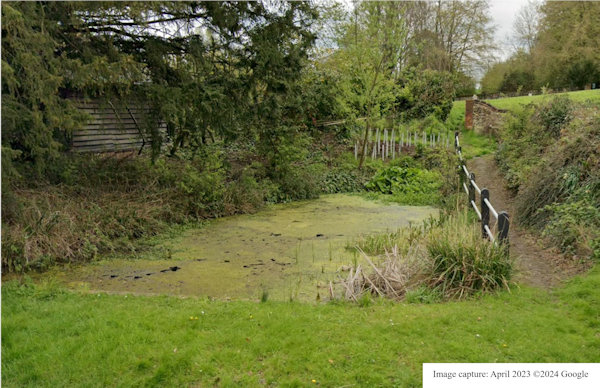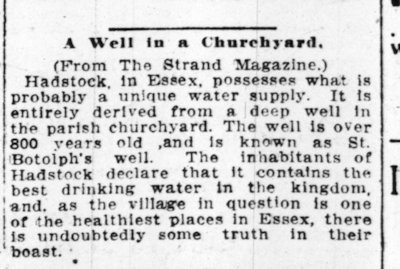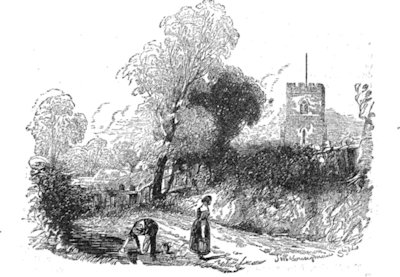 |
Dedication: Saint Botolph Location: Hadstock Coordinates: 52.079692N, 0.273114W Grid reference: TL558448 Heritage designation: none |
 |
Dedication: Saint Botolph Location: Hadstock Coordinates: 52.079692N, 0.273114W Grid reference: TL558448 Heritage designation: none |
According to local tradition, the body of St Botolph was entombed somewhere in the church in the 7th century, although this is very unlikely; instead, it is thought that he was buried in Iken, a village in Suffolk at which he founded a monastery. The relics of the saint were later translated to Thorney Abbey in Cambridgeshire, although several of his body parts were at the same time distributed around the country (such as St Botolph's head, which was given to Ely Abbey), so it is possible - yet extremely unlikely - that the village church came to possess, say, the finger bone of St Botolph at this time. Regardless of whether the church came to possess his relics, St Botolph almost certainly visited Hadstock during his time working as a missionary in East Anglia, and he probably founded Hadstock's church.
The first known reference to St Botolph's Well can be found in Description of England, which was written by William Harrison in 1567, and states that "many miracles" had occured at the well. It seems, however, that the Reformation saw an end to the well's reputation for effecting miracles, as all later accounts leave out any mention of miraculous events. A detailed description of the well is given in an anonymous publication from 1769, entitled A New and Complete History of Essex, Volume II, which the author (who simply refers to himself as "a Gentleman") claims was "compared with the moſt celebrated Hiſtorians":
|
In the church yard is a well ſet round with ſtones; a little above which are ſtone ſteps that lead to an area paved with broad ſtones, deſcending ſlope-wiſe into the well, as is uſual in baths. The waſte water ſupplies with a continual ſtream another well juſt without the church-yard, called St. Botolph's-well. We have not any hiſtory or tradition of miracles being performed by either. |
The well was also described by Philip Morant in 1768, in Volume II of the History and Antiquities of the County of Essex, and his report of the well's condition is almost identical to the one that was given a year later by the anonymous "Gentleman". During the 19th century, several authors made reference to the well, including Thomas Wright, in his 1831 publication The History and Topography of the County of Essex; Thomas Dugdale, in England and Wales Delineated (1853), who stated that the well was "set around with stones"; and John Player, in Sketches of Saffron Walden and its Vicinity from 1845, part of which featured in The Gentleman's Magazine. In 1916, the Royal Commission stated that St Botolph's Well was "now covered"; it is uncertain whether this was actually correct. The well also enjoyed an unexpected period of fame in 1908 when it appeared in not one but four (at least) popular magazines and newspapers: Volume 40, Issue 302 of The Atlanta Constitution; Volume 31, Issue 20 of The American Machinist; an issue of The Strand Magazine; and Volume 105 of The Engineer, all of which featured almost identical descriptions of St Botolph's Well. (Unfortunately, all of the magazines incorrectly stated that St Botolph's Well was a "deep well", when in fact it was more of a pond, and still is today.) The image below is from The Atlanta Constitution:
 |
Despite the anonymous "Gentleman"'s statement that no traditions were known to be associated with the well, this is simply untrue. The well was at one time, likely before the Reformation, particularly well regarded as being effective in the curing of the King's Evil (now known as scrofula), a disease that was common during the Medieval era. It was also believed that if a girl dropped a ring in the well then she would find her true love; this tradition either predated the Reformation and survived it or developed at some point after it (the latter being more likely). At one time, possibly during the Victorian era, but maybe earlier, dead cats were often deposited in the well by a "white witch" to purify the water; the amount to which this practice improved the water quality is of course questionable. At some point after this, presumably after this strange custom had been abolished, the well's water was again polluted - and this time by the local vicar, who was using the well as an outlet for his lavatory. For many centuries, St Botolph's Well had supplied the village with its water, and it did so until the early 20th century; when the water became polluted, forty people died from typhoid after drinking it. (Unfortunately, how much truth this story holds has been questioned, as there remains no official record of any typhoid outbreak in the area.)
Until recently, the well was covered over "for safety reasons", but it appears that it has now been uncovered and currently takes the form of a pond. The well is marked and named on old Ordnance Survey maps (although it is not today) and is shown to be the spring that feeds this pond. From 1896 until recently, a pump has been marked on OS maps on the opposite side of the road, adjacent to the spring; this appears to have been connected to St Botolph's Well. This pump no longer exists.
 |
|
Access: The pond is located beside the road, and a public footpath runs next to it. |
Copyright 2025 britishholywells.co.uk